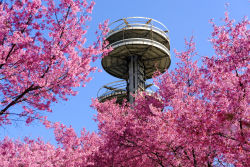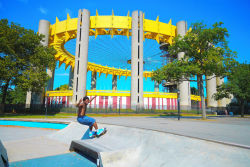Flushing Meadows Corona Park
Malcolm X Promenade
What was here before?
The promenade rims a waterway that once fed into a tidal estuary plied by Native Americans, later fished by early European settlers, and then despoiled as an industrial dumping ground. The New York World’s Fair of 1939-40 helped clear and upgrade the land for use as a public park.
How did this site become a promenade?
The Flushing Bay promenade and marina were part of several facilities resulting from the conversion of the vast industrial tract for use as the New York World’s Fair of 1939-40. Steel piling along the bay’s southern shoreline formed a “structural backbone” for the curved promenade, then 25 feet wide and 950 feet long. Landscaped with grass panels lined with trees, and nautically-styled ships railings along the stabilized water’s edge, the walkway created an attractive vista at this formerly derelict waterfront.
In preparation for 1964-65 World’s Fair, architect Peter Schladermunt updated the promenade and marina and designed the distinctive wavy shade structures fabricated by Owens Corning Fiberglass Corporation. In 1989, artist Jackie Ferrara was commissioned to create the promenade’s geometric paving patterns. In 1999, the promenade was renovated, and now stretches 1.4 miles from LaGuardia Airport to Harper Street.
Who is this promenade named for?
In 2021, as part of the second phase of NYC Parks’ initiative to expand the representation of African Americans honored in parks, this park feature was named for political and religious leader Malcolm X (el-Hajj Malik el-Shabazz) (1925-1965).
Malcolm X was born Malcolm Little in Omaha, Nebraska, the son of Louise and Earl Little. The family moved to Michigan, and Earl, an outspoken critic of racial injustice and follower of Marcus Garvey, was killed when Malcolm was six. Louise suffered a nervous breakdown when Malcolm was in middle school, and he was the raised by white foster families.
Though excelling in school, Malcolm dropped out of high school, feeling alienated by a racist society. As a young adult he worked for the New Haven Railroad, and later living in Boston and Harlem engaged in various illegal activities and was imprisoned in 1946 for burglary.
In prison, Malcolm became an avid reader and joined the Nation of Islam. Paroled in 1952, he met with Elijah Muhammed, the leader of the Nation. A highly charismatic minister and speaker, Malcolm rose through the organization, established several temples, and become a key spokesperson. A deeply moral man, he also described himself as “the angriest Black man in America.” For his demonization of a corrupt racist white society and advocacy of violent action as necessary in defense of Blacks, he was vilified in mainstream media and the subject of FBI investigations.
He married Betty Shabazz and moved his family in 1956 to 97th Street in East Elmhurst, near LaGuardia Airport and the Flushing Promenade. After a trip to Mecca in 1964, where he witnessed the breadth of Muslim culture, he tempered his views of whites. He was the target of death threats after he broke with the Nation of Islam’s leadership. His home was firebombed on February 14, 1965, and a week later he was assassinated while speaking at the Audubon Ballroom in Manhattan. His life and philosophy are chronicled in The Autobiography of Malcolm X, as told to author Alex Haley, and published posthumously in 1965. Malcolm X’s teachings were important in the Black Power movement and remain influential on public discourse on race relations and societal power structures.
Check out your park's Vital Signs
Clean & Safe
Green & Resilient
Empowered & Engaged Users
Share your feedback or learn more about how this park is part of a
Vital Park System

Know Before You Go

Downloads
- New York State Pavilion Listening Session
- Strategic Framework Plan: Introduction
- Strategic Framework Plan: Site Analysis
- Strategic Framework Plan: Conceptual Framework, Part I
- Strategic Framework Plan: Conceptual Framework, Part II
- Strategic Framework Plan: Vision and Goals, Part I
- Strategic Framework Plan: Vision and Goals, Part II
- Strategic Framework Plan: Appendix, Part I
- Strategic Framework Plan: Appendix, Part II
Links
- National Tennis Center Strategic Vision Project
- World Ice Arena
- Citi Field
- Mets Ticketing
- USTA National Tennis Center
- US Open
- Terrace on the Park Catering Hall
- New York Hall of Science
- Queens Museum
- Queens Botanical Garden
- Queens Theatre
- Queens Wildlife Conservation Center
- Fantasy Forest at the Flushing Meadows Carousel
- Wheel Fun Rentals
- Alliance for Flushing Meadows Corona Park
Contacts
General Park Info: (718) 760-6565
Pitch N Putt Golf and Miniature Golf : (718) 271-8182
World's Fair Marina on Flushing Bay : (718) 478-0480
World's Fair Marina Restaurant: (718) 898-1200
Terrace on the Park: (718) 592-5000
Citi Field: (718) 699-4220
Mets Ticketing: (718) 507-TIXX
USTA National Tennis Center: (718) 760-6200
US Open/USTA: (914) 696-7000
New York Hall of Science: (718) 699-0005
Queens Museum: (718) 592-9700
Queens Botanical Garden: (718) 886-3800
Queens Theatre: (718) 760-0064
Queens Wildlife Conservation Center: (718) 271-1500
Sports Permits: (718) 393-7272
Picnic/Barbeque Permit for Large Groups: (718) 393-7272
Wheel Fun Rentals: (917) 231-5519
World Ice Arena: (718) 760-9001
Al Oerter Recreation Center: (718) 353-7853
Flushing Meadows Corona Park Pool & Rink: (718) 271-7572
Special Events Permits: (718) 760-6560
Tennis Permits: (718) 393-7276
Volunteer Coordinator: (718) 760-6561










